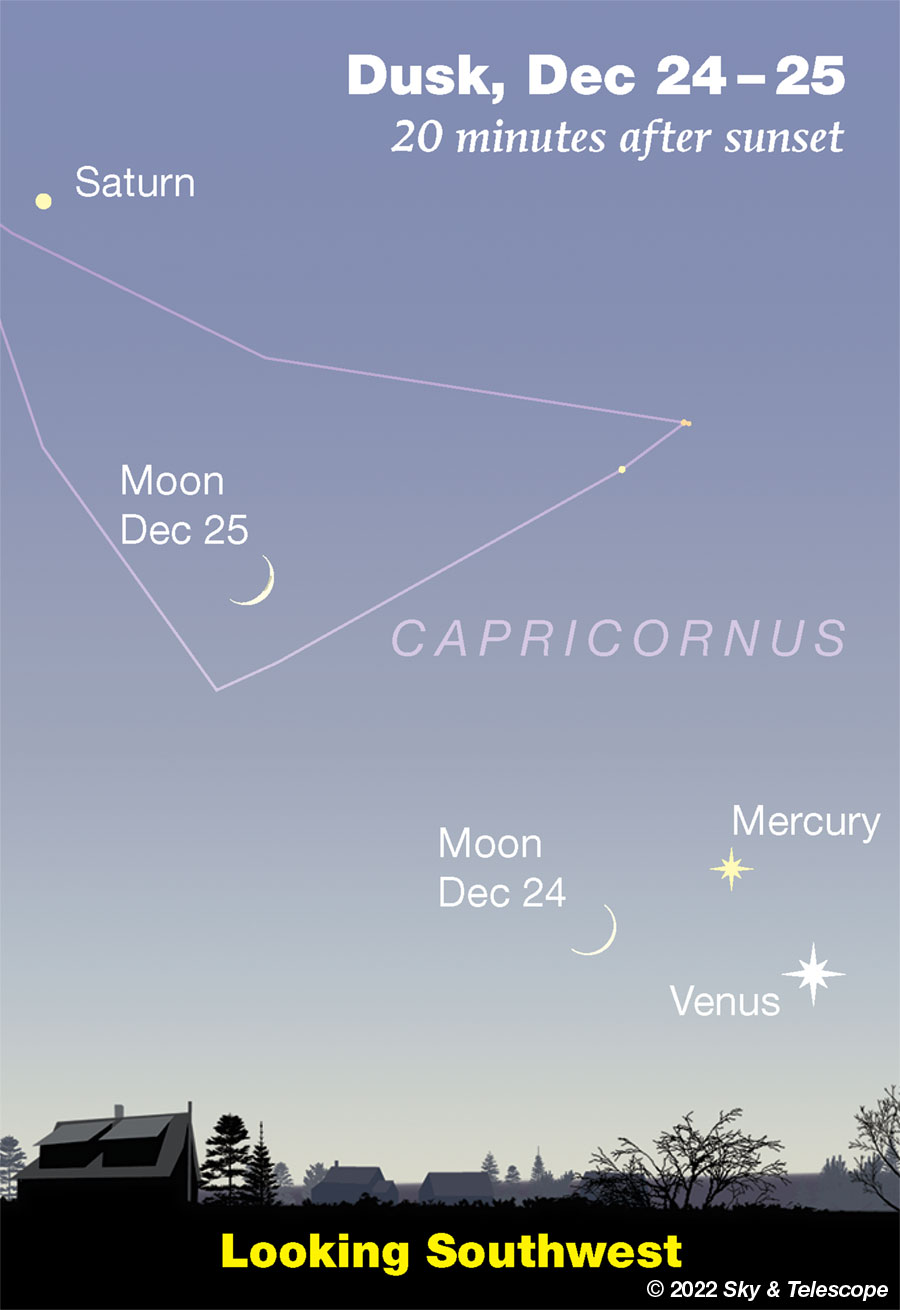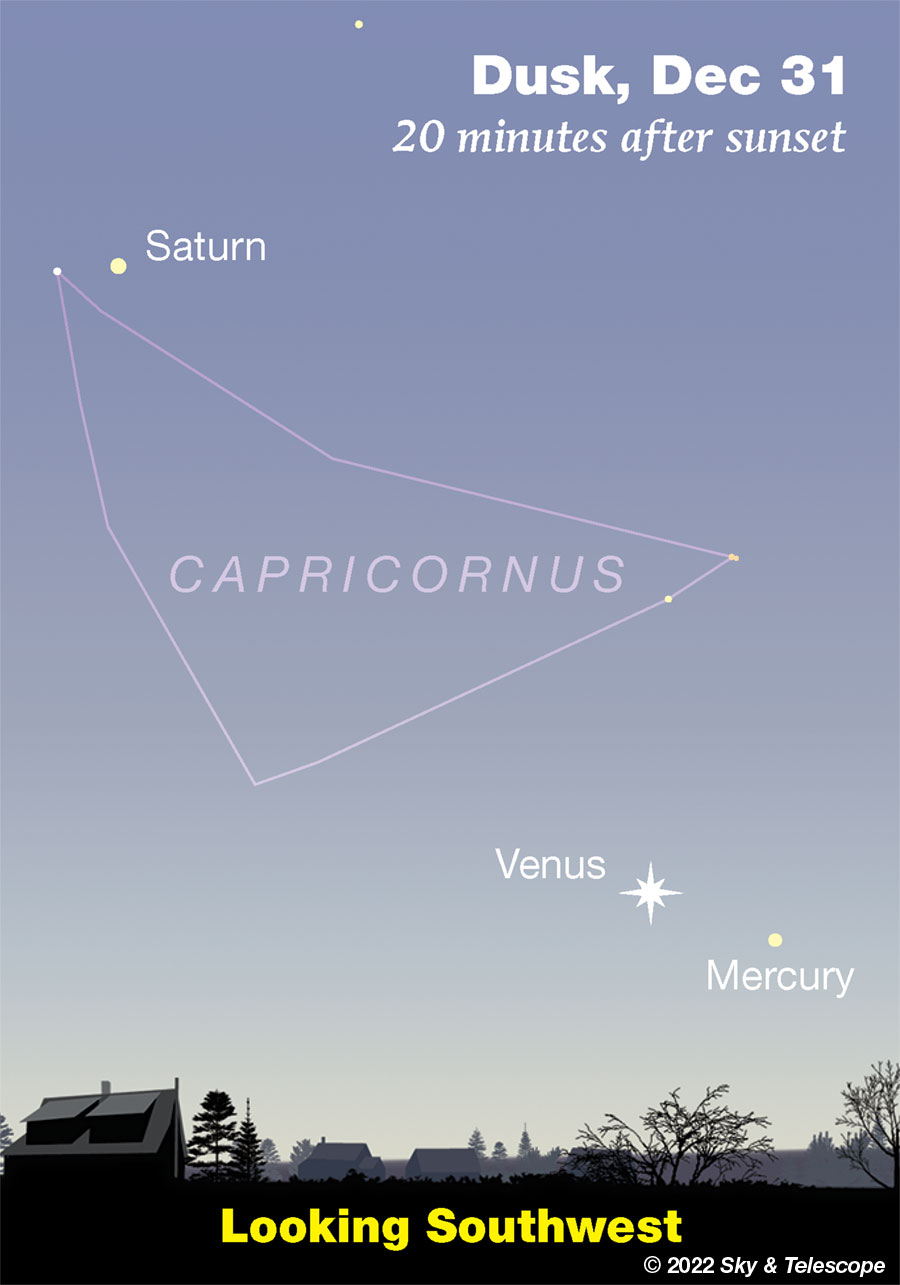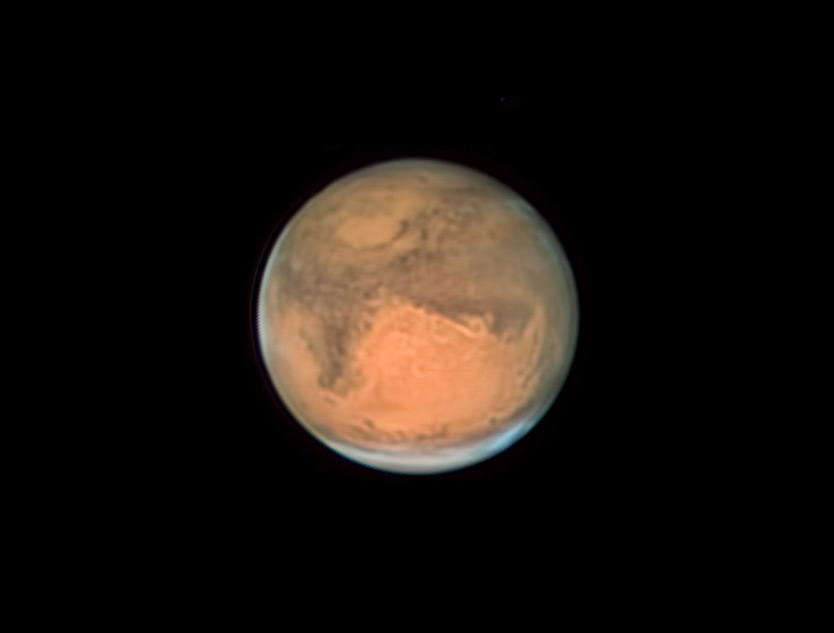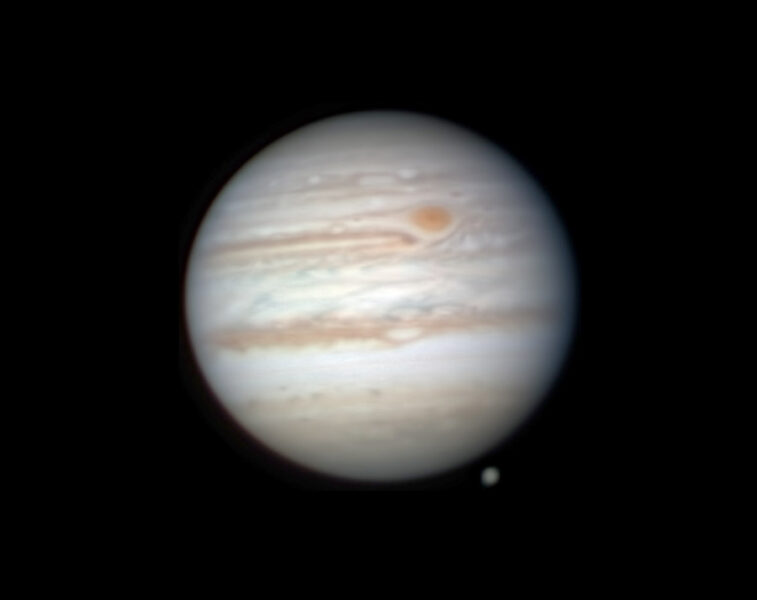FRIDAY, DECEMBER 23
■ Orion is getting well up in the east-southeast after dinnertime, with his three-star belt still nearly vertical. The belt points up toward Aldebaran, with brighter Mars nearby, and onward even higher toward the Pleiades. In the other direction, the belt points down to where bright Sirius rises around 7 or 8 p.m. to twinkle furiously.
■ Aldebaran shines near the edge of the large, loose Hyades cluster in its background. Binoculars are the ideal instrument for this cluster given its size: its brightest stars (4th and 5th magnitude) span an area about 4° wide, and sparse fainter members extend much farther. Higher above, the Pleiades appear hardly more than 1° across (counting just the brightest stars).
The main Hyades stars famously form a V. It's currently lying on its side, open to the left. Aldebaran is the lower of the V's two tips.
With binoculars, follow the lower branch of the V to the right from Aldebaran. The first thing you come to is the House in the Hyades: a pattern of stars like a child's drawing of a house with a peaked roof. The house is currently upright and bent to the right like it got pushed.
The House includes three binocular double stars that form an equilateral triangle, with each pair facing the others. The brightest pair is Theta1 and Theta2 Tauri. Maybe you can resolve the Theta pair with your unaided eyes.
■ New Moon (exact at 5:17 a.m. EST on this date). A new lunar month begins. Unlike our calendar month, which averages 30.437 days long, the lunar month (from one new Moon to the next) averages 29.531 days. This means that on average, you'll see the Moon in any given phase about one day earlier each month by the calendar.
SATURDAY, DECEMBER 24
■ Starting 20 minutes after sunset, use binoculars to look low above the southwest horizon for Venus. Once you get it, watch for Mercury 4° to its upper right (an easy fit in a binocular field), and a very thin fingernail-clipping of a crescent Moon a similar distance to Mercury's lower right. See the scene below.
The Moon is only 1½ days old at dusk in the longitudes of the Americas. Can you observe the earthshine on the Moon's dark portion?

■ Writes Gary Seronik in the December Sky & Telescope,
"Enjoy some extra holiday cheer [soon after dusk] courtesy of a 90° string of lights. It includes, from south to west-northwest, Fomalhaut, Saturn, Altair, and Vega. The quartet are similarly bright — only a touch more than a magnitude distinguishes the brightest light in the string (Vega) from the faintest (Fomalhaut)." And they're about equally spaced.
SUNDAY, DECEMBER 25
■ The crescent Moon, thicker than yesterday, now shines about two fists upper left of Venus, as shown above. Saturn glows about one fist over the Moon.
■ For central and western North America, Jupiter's moon Io reappears out of eclipse by Jupiter's shadow at 8:21 p.m. CST, 7:21 MST, 6:21 PST. In a telescope at 100x or more, watch for it to gradually appear into view very close to Europa just a little off Jupiter's eastern (following) limb. First there will be one moon right there, then two.
MONDAY, DECEMBER 26
■ Saturn and the crescent Moon pair up in the southwest during and after dusk. They're only about 3° apart. Look for Fomalhaut sparkling off to their left.
TUESDAY, DECEMBER 27
■ Sirius and Procyon in the balance. Sirius, the Dog Star, sparkles low in the east-southeast after dinnertime. Procyon, the Little Dog Star, shines in the east about two fist-widths at arm's length to Sirius's left.
But directly left? That depends. If you live around latitude 30° (Tijuana, New Orleans, Jacksonville), the two canine stars will be at the same height above your horizon soon after they rise. If you're north of that latitude, Procyon will be higher. If you're south of there, Sirius will be the higher one. Depending on your latitude, your eastern horizon tilts differently with respect to the stars.
WEDNESDAY, DECEMBER 28
■ Venus and Mercury are only about 2° apart this evening and tomorrow evening, very low in the southwest in bright twilight. Today Mercury is upper right of Venus. Tomorrow it's directly right of Venus.
THURSDAY, DECEMBER 29
■ First-quarter Moon (exact at 8:21 p.m. EST). As twilight descends with the Moon high in the south, you'll soon see Jupiter a few degrees to the Moon's right (for North America). As evening proceeds, they sink toward the west and Jupiter tilts downward to shine to the Moon's lower right.
Since the Moon is at first quarter, Jupiter near it must be about at quadrature. Why? The words quarter and quadrature hold the clue. Both word-roots mean 1/4. The Moon and Jupiter are both about a quarter of the way around the ecliptic (90°) from the Sun.
When Jupiter is at quadrature, its eastern and western limbs are illuminated as differently as you'll ever see them. The west side is currently brighter, since it faces a little more directly to the Sun, and the east limb is a little shadier. Jupiter in a telescope is so bright to the eye that the difference isn't very striking, due to overexposure. But you often see this effect plainly in photos, such as the one farther down this page.
FRIDAY, DECEMBER 30
■ Cassiopeia is usually called a flattened letter W, but now it's a flattened M very high overhead around 7 or 8 p.m, just a little west of north.
Three hours later it has turned around to stand on one end high in the northwest.

SATURDAY, DECEMBER 31
■ In the evening sky, the Moon is poised almost midway between Jupiter far its right and Mars far to its left.
■ After the noise and whoopla at the turning of midnight tonight, step outside into the silent, cold dark. Shining high in the south will be Sirius, with the other bright stars of Canis Major to its right and below it. Sirius is the bottom star of the bright, equilateral Winter Triangle. The others are Betelgeuse in Orion's shoulder to Sirius's upper right, and Procyon the same distance to Sirius's upper left. The Triangle now stands upright, just about in balance on the point of Sirius. Happy New Year.
This Week's Planet Roundup
All eight planets are lined up across the evening twilight sky, echoing their similar lineup in the dawn sky late last spring and early summer. See Bob King's All Eight Planets Line Up... Again. Don't wait; Mercury is fading fast.
Mercury and Venus pass each other this week very low in the southwest in twilight. Try for them with binoculars about 30 minutes after sundown. Venus is by far the brightest at magnitude –3.9. Mercury begins the week 4° upper left of it on Christmas Eve, as shown at the top of this page. They pass 1.7° apart on the 29th, with Mercury now to Venus's right. Thereafter Mercury sinks away fast, while Venus continues creeping a little upward.
During this time Mercury fades rapidly: from magnitude –0.3 on December 24th to +0.8 by the 31st, a loss of two thirds of its light in seven days.
Mars continues to fade slowly, from magnitude –1.4 to – 1.2 this week, as it shrinks from 15.2 to 14.7 arcseconds wide. It shines like a firespark in the east as the stars come out, much brighter than orange Aldebaran to its lower right (mag +0.8). Mars gains altitude until culminating nearly overhead around 10 p.m., when the telescopic seeing for it will likely be best.
Mars has passed between Aldebaran and Capella, the bright star almost three times as far to Mars's opposite side. The planet was exactly between them on December 14th, moving west. Watch it creep farther out of this alignment day by day.
It will reverse direction and go back between those two stars in February. Bonus points: Can you say why? Answer at the bottom of this page.*

Jupiter blazes whitely high in the south in twilight, then sinks toward the southwest. At magnitude –2.4 it vastly outshines the background stars of dim Pisces. Look for the Great Square of Pegasus above it as the stars come out, and upper right of it later through the evening. Jupiter sets around 11 or midnight. Telescopically, Jupiter is down to 40 arcseconds wide.

Saturn, magnitude +0.8 in Capricornus, is getting low in the southwest at nightfall, far to the lower right of Jupiter. Catch Saturn as early as you can; it's on the way down and sets around 8 p.m. It's not quite halfway between Fomalhaut (to its left) and Altair (to its right).
Uranus, magnitude 5.7 in Aries, moves high across the south during evening. It displays a tiny, very slightly blue-greenish gray disk 3.7 arcseconds wide. It a telescope at high power it's obviously non-stellar. See the Uranus finder charts in the November Sky & Telescope, page 49.
Neptune, magnitude 7.9 at the Aquarius-Pisces border about 8° west of Jupiter, is getting lower in the evening. It's just 2.3 arcseconds wide, again non-stellar in a telescope but requiring more effort than Uranus. It's slightly bluish gray, if you have enough aperture to show color at all in something this faint. See the Neptune finder charts in the September Sky & Telescope, page 49.
All descriptions that relate to your horizon — including the words up, down, right, and left — are written for the world's mid-northern latitudes. Descriptions and graphics that also depend on longitude (mainly Moon positions) are for North America.
Eastern Standard Time (EST) is Universal Time minus 5 hours. Universal Time is also called UT, UTC, GMT or Z time.
Want to become a better astronomer? Learn your way around the constellations. They're the key to locating everything fainter and deeper to hunt with binoculars or a telescope.
This is an outdoor nature hobby. For an easy-to-use constellation guide covering the whole evening sky, use the big monthly map in the center of each issue of Sky & Telescope, the essential magazine of astronomy.
Once you get a telescope, to put it to good use you'll need a detailed, large-scale sky atlas (set of charts). The basic standard is the Pocket Sky Atlas (in either the original or Jumbo Edition), which shows stars to magnitude 7.6.

Next up is the larger and deeper Sky Atlas 2000.0, plotting stars to magnitude 8.5; nearly three times as many. The next up, once you know your way around, are the even larger Interstellarum atlas (stars to magnitude 9.5) or Uranometria 2000.0 (stars to magnitude 9.75). And be sure to read How to Use a Star Chart with a Telescope. It applies just as much to charts on your phone or tablet as to charts on paper.
You'll also want a good deep-sky guidebook. A beloved old classic is the three-volume Burnham's Celestial Handbook. An impressive more modern one is the big Night Sky Observer's Guide set (2+ volumes) by Kepple and Sanner.
Can a computerized telescope replace charts? Not for beginners, I don't think, and not on mounts and tripods that are less than top-quality mechanically, meaning heavy and expensive. And as Terence Dickinson and Alan Dyer say in their Backyard Astronomer's Guide, "A full appreciation of the universe cannot come without developing the skills to find things in the sky and understanding how the sky works. This knowledge comes only by spending time under the stars with star maps in hand."
![]() Audio sky tour. Out under the evening sky with your
Audio sky tour. Out under the evening sky with your
earbuds in place, listen to Kelly Beatty's monthly
podcast tour of the heavens above. It's free.
"The dangers of not thinking clearly are much greater now than ever before. It's not that there's something new in our way of thinking, it's that credulous and confused thinking can be much more lethal in ways it was never before."
— Carl Sagan, 1996
"Facts are stubborn things."
— John Adams, 1770
*Answer to why Mars reverses direction. All the planets move eastward against the background stars most of the time. That's because that's the direction the planets orbit around the Sun. But, so does Earth. Because we orbit faster than the outer planets do (since we're closer to the Sun), when we are between the Sun and one of them, it appears to us to move backward against the stars for a while. That is, westward.
This is called their "retrograde loop." It gave fits to the pre-Copernican astronomers who assumed that Earth was motionless and the center of everything. It fell right into place when Copernicus realized the Earth it a moving planet too.
 6
6









Comments
Rod
December 24, 2022 at 6:16 am
I went out early this morning to observe this comet. Observed 0430-0530 EST. I was able to view ZTF C/2022 E3 this morning using my 90-mm refractor with TeleVue 32-mm plossl and TeleVue 14-mm Delos eyepieces. 31-71x views. Distinct stubby fan shape tail with coma. The star TYC2040-488-1 about 9 arcminute angular separation from the comet and 8.15 apparent magnitude. Starry Night shows the comet 8.59, Stellarium 1.1 shows 8.59 apparent magnitude. These estimates looked good for brightness of C/2022 E3 ZTF. I received a report on this comet from spaceweather.com yesterday so this morning I tracked it down in Corona Borealis. A Christmas comet 🙂 Temperature -14C, winds 270/7 knots, clear skies. The wood burning stove is running and felt great when I came back inside.
You must be logged in to post a comment.
mary beth
December 25, 2022 at 10:12 am
Merry Christmas all!
Such a beautiful scene last evening, seeing the Christmas Eve crescent moon near Venus and Mercury. I had a perfect view in the southwest. Such a lovely sight!
God bless us, everyone!
You must be logged in to post a comment.
Rod
December 25, 2022 at 11:32 am
Very good mary beth. I watched Muppets Christmas carol last night with Tiny Tim and Michael Kaine as Scrouge 🙂 Always enjoyable. I may get out and look at Mars again tonight with my 90-mm refractor telescope.
You must be logged in to post a comment.
cyrtonyx
December 26, 2022 at 2:07 pm
Yes,
It was a beautiful sight in the SW. All that was needed was a super bright, long-tailed comet!
You must be logged in to post a comment.
Rod
December 25, 2022 at 9:46 pm
I did observe Mars tonight along with some faint stars too. Observed 1900-2030 EST/0000-0130 UT. I used my 90-mm refractor telescope with TeleVue 40-mm plossl and 14-mm Delos for 25x and 71x views of Mars tonight. Some surface features visible at 71x and Mars a distinct planetary shape at about 15.4 arcseconds angular size. The Sky & Telescope Mars Profiler tool for 0143 UT showed central meridian longitude = 33 degrees. I tested stars visible in the FOV about 60 arcminutes or a bit larger around Mars position. Using Stellarium 1.1, Starry Night Pro Plus 8, and SIMBAD portal for looking up, I could see stars with apparent magnitude 7.43 to as faint as 11.57 (SIMBAD). HD 283718 or TYC1833-815-1 looks like the faintest, about 11.57 magnitude according to SIMBAD portal and some 1930 light-years distance using stellar parallax 1.6895 mas. Mars and the star were separated by 32.45 arcminutes and Mars about 0.607 au distance. A number of other stars in the FOV about 19-55 arcminutes from Mars position in the 10.0-10.3 magnitude range. Some of the brighter stars were HIP211103 and HIP21174 in Taurus, some 7.4-8.5 magnitude or so. Skies clear, temperature -7C winds 360/7 knots. A good test of my 90-mm refractor. It is rated for apparent magnitude 12.0 stars. The wood burning stove is running 🙂
You must be logged in to post a comment.
Rod
December 25, 2022 at 11:25 pm
HIP211103, oops 🙂 HIP21103 along with HIP21174, two brighter stars visible in the FOV with Mars.
You must be logged in to post a comment.
You must be logged in to post a comment.